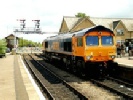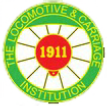Archive Section




© Text by John Hayward
Wednesday 6th July 2016
On Wednesday morning,6th July,2016, I joined a group of ten members of the Locomotive & Carriage Institution to visit the former St.Albans South signal box. It was commissioned on 12th June,1892 and is now preserved, having been replaced on 1st/2nd December, 1979 by a modern power signal box in West Hampstead. The latter, in turn, is now due to be replaced by the Sussex and East Midlands Regional Operations Centres at Three Bridges and Derby, respectively, by 2019.
After closure, the old signalbox was retained for a while, being used by the St.Albans station announcer. This use only lasted a short while, but it was during this period that the box and its frame were listed Grade II on 23rd February,1979. This was on the grounds that it was a good unaltered example of a 3 bay Midland Railway signal box contemporary with the opening of the main line through to St Pancras.
The signal box is timber framed with weather-
After the box became disused, BR received approval from the local council in October,1980 to demolish the box, as it was to be rebuilt in the former Crystal Palace Low Level goods yard. Here, it was to form part of a proposed new rail and bus museum centre, but this never gained approval and did not proceed.
In November, 1981, BR again applied to demolish the box on the grounds that they did not want vandals and young children playing in the box close to the main lines, as it could be dangerous. This was rejected and over the next few years, the box slowly deteriorated, although BR and its successor Railtrack did board up the windows and repair the roof.
Local residents started to complain about the signalbox's condition and that it was an eyesore. Eventually, they decided to form a trust in 2002, now known as the St.Albans Signal Box Preservation Trust, to restore and manage the box.
In 2005, Lafarge Aggregates Limited, granted the Trust a sum of money towards the restoration and, in particular, the proposed landscaping around the box. Network Rail erected fencing around the box to delineate the area, to be leased, to protect visitors from the main lines and the 25kV AC overhead wires. This was followed in the Spring, 2006, by the Trust and Network Rail agreeing a 25 year lease over the site, which meant that work could commence in earnest.
In September, 2006, the site was opened to the public for the first time during the national Heritage Open Weekend, although access to the box was not possible.
The box sits on a wooden sleeper base which was in quite good condition but the lower wood work of the box was showing extensive areas of rot and needing replacement. Our group was informed that the condition of the timbers was so bad, that only thing stopping the box falling over was the heavy weight of the lever frame pressing downwards! This work included replacing the lower parts of most of the main corner posts by new timber. By August, 2007 the underpinning was nearly complete, with new sole plates and 7 of the 8 main supporting timbers replaced. The timbers are huge, and are expected to easily last another 100 years.
The exterior first floor toilet block, added by BR in 1963, was in poor condition and it was decided to remove it. Before this could take place, nature assisted the project when a December,2006 storm resulted in the block collapsing and it even fell the right way -
New stairs were added in 2008 and for the first time visitors were able to visit the first floor and see the internal working of the box, as well as watch main line trains speed past. The same year, saw the box repainted in the correct Midland Railway colours after consultation with the NRM.
The signal box trust is run a group of volunteers who have done a wonderful job restoring the box and creating a lovely garden next to it. The Signalman's Garden has over had over 200 shrubs and trees planted as well as some items of railway interest such as signals. Some of the latter allow demonstration of aspects of signalling practice. There are also two rather nice old Midland Railway gas lamps which have been adapted for electricity. In addition, there are demonstrations of four aspect colour light signalling and even three of the latest new LED signals. The wiring up of the latter was completed on the day of our visit. Also, in the garden is a nicely restored old trolley built to carry coffins.
Incidentally, the volunteers guiding us around the site referred to the building as an IKEA signal box! They explained that the parts for the building (known as a Type 2a three bay type) and a 44 lever ‘Tumbler interlocked' lever frame, were prefabricated at the Midland Railway's works in Derby and then brought to St.Albans to be assembled on site. The frame was later replaced by present one in April,1906. As mentioned earlier, the signalbox is very close to the main line from St.Pancras to Leicester, Derby, Nottingham, Sheffield, etc. and when trains pass by at 100mph, you can feel the building move slightly.
It is also located close to the south end of platform 4 of St.Alban's City station and access is via Ridgmont Road. It is open on the second and fourth Sunday afternoons (14.00 to 17.00) of each month from April to October plus certain other dates advertised on the Trust's website -
As an add on to this visit, the organiser had arranged a visit to the De Havilland Aircraft museum but only two of the group were interested in doing this. Me and another chap. I never saw the latter again, so I don't know if he ever got there.
I travelled by no.84 bus, from near St. Albans City station, to the nearest stop to the museum which was out in the sticks near London Colney and also the busy M25. About a 25 minute bus journey.
Fortunately, the bus driver pointed out where I had to go. The museum was not very well sign posted and is about 150 yards down a single track lane through open fields. Eventually, I came to a large house and a large barn. The latter converted to a home. Behind, these buildings, I found the museum after I spotted an aircraft in the distance.
When I got to the entrance, I found that the door was closed, although a sign said that it was open from 10.30. A passing volunteer told me that it was closed and is only open on Wednesdays during the school holidays.
However, it would be OK to have a look around, if I asked a chap in the office. I never found the office or the chap!
I still had a very good look around the various museum buildings and no one bothered me -
The aircraft on display included a Tiger Moth, part of a Comet airliner,a DH104 Dove,a DH114 Heron and a Vampire jet. The latter was one the main RAF jet fighter aircraft when I was in the RAF and so was of particular interest to me. There were many other aircraft there such as three WW2 Mosquito aircraft which were made mainly of wood as well as parts of two WW2 Horsa towed transport gliders.
In addition, there was a DH89A Dragon Rapide which is an all-
During the ten years it was in production, 728 were built for commercial and military use, the latter as the Dominie. By 1942 production at Hatfield had reached a total of 346 Dragon Rapides and Dominies, but space was urgently needed for Mosquito production, so Dominie assembly was taken over by the Brush Coachworks at Loughborough, where a further 346 were built between 1943 and 1945. This firm had originally started in 1865 when Henry Hughes, who was a timber merchant engineer, began building horse-
The Museum’s exhibit, registration G-
Incidentally, I discovered later that the large building, I had seen earlier as I approached the museum, is Salisbury Hall. It was originally built in 1507 and is surrounded by a moat. The financier, Sir Jeremy Snow bought the house in 1669 and rebuilt it. He was a close friend of Charles II and the King and his long time mistress,the actress Eleanor ‘Nell’ Gwynne, were regular visitors. In the grounds overlooking the moat, Snow built a small oak beamed house which today is still known as Nell Gwynne’s cottage. Charles II continued his illicit liaisons with Nell Gwynne at Salisbury Hall for several years until his death in 1684. Nell followed her lover to the grave three years later, dying at her London house in Pall Mall in 1687 aged 37.
Salisbury Hall passed through various hands, and during the latter part of the 19th century was occupied by a succession of farmers. However, about 1905 Lady Randolph Churchill, as Mary Cornwallis West, came here to live. Her son, Winston Churchill, became a regular visitor, as did King Edward VII and the singer Dame Nellie Melba.
During the 1930s Sir Nigel Gresley, of the London and North Eastern Railway, was in residence. He was responsible for the A4 Pacific Steam Locomotives one of which, Mallard, holds the world speed record for steam locomotives of 126.5 mph. Rumour has it that the name came from the ducks in the moat.
As a matter of interest, Nell Gwynne's cottage was later used, after WW2, as a silkworm factory, surrounded by a silk worm farm, and which supplied the silk for the Queen's wedding in 1947 and Coronation robes in 1953.
The de Havilland Aircraft Museum was the first aviation museum in Britain, when it opened to the public on 15 May 1959, just 18 years after the Mosquito Night Fighter W4052 had been flown out of adjacent fields by Geoffrey de Havilland Jnr.
Aviation first came to Salisbury Hall in October 1939 when the de Havilland Mosquito design team moved in as a security precaution against the British Government stopping work on the project. The Mosquito was designed initially as an unarmed high speed bomber, later being developed into the first multi-
De Havilland left in 1947 and the Hall slipped into a derelict condition. In 1955 the Hall was taken in hand by an ex Royal Marine Major named Walter Goldsmith. After learning of De Havilland's involvement with his home, he offered accommodation for the Mosquito Prototype W4050 then stored unwanted at Hatfield. It returned to become the first aviation exhibit housed in a hangar behind Salisbury Hall.
An interesting if somewhat impromptu visit and I returned back to the station and home by train.
.